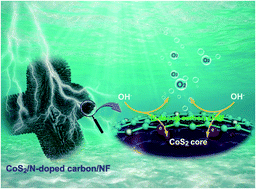CoS2@N-doped carbon core–shell nanorod array grown on Ni foam for enhanced electrocatalytic water oxidation†
Abstract
Developing a highly efficient and low-cost oxygen-evolution-reaction (OER) electrocatalyst is an important route to overcome the rate-determining step of water splitting. Here, we directly grew a CoS2 nanoarray core with an N-doped graphitic carbon (NGC) shell on Ni foam (NF) to construct a core–shell nanorod array electrode, CoS2@NGC@NF. The CoS2 core with a high work function (∼5.5 eV) tends to capture electrons from the NGC layer (4.5–5.2 eV) to induce an electron-poor NGC shell with a significant downshift of the carbon Fermi level, facilitating the adsorption of O-containing intermediates and affording decreased activation energy during the OER process. As a result, the three-dimensional NGC encapsulated CoS2 array assembly exhibited excellent electrocatalytic OER activity with a low overpotential of 243 mV at a current density of 10 mA cm−2 and a small Tafel slope of 71 mV dec−1 in 1.0 M KOH. Our findings may suggest that manipulating the interface energetics by the work function difference is a potential route to the design of high-performance OER electrocatalysts.



 Please wait while we load your content...
Please wait while we load your content...